#AOL Girls Museum
Photo
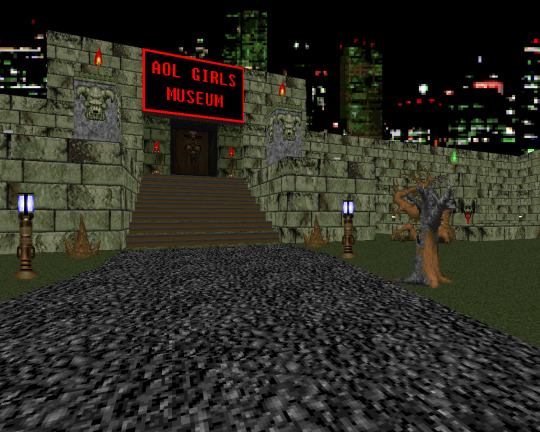
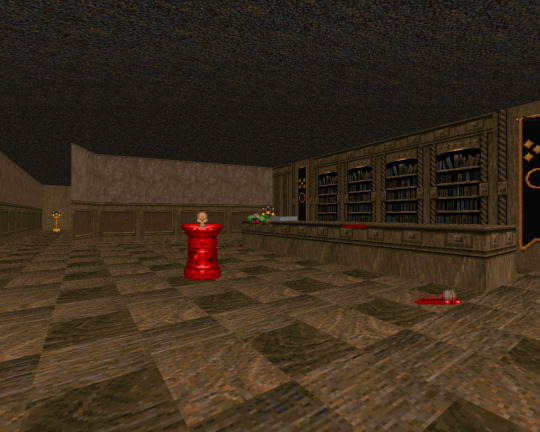
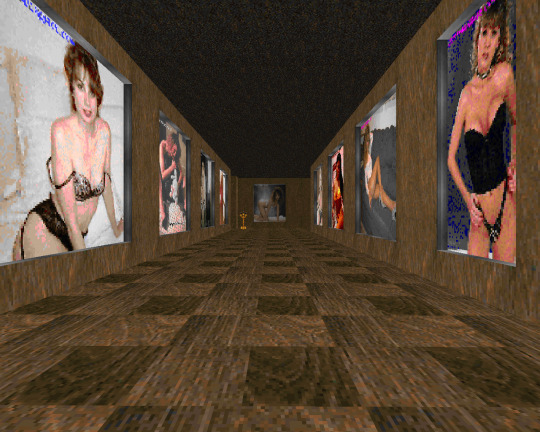

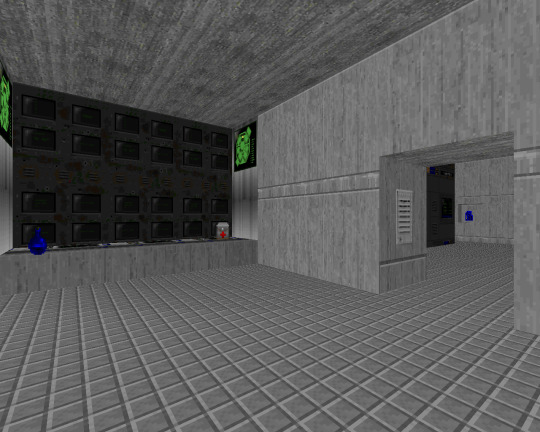

AOL Girls Museum
Game: Doom II
Year: 1998
Source Port: Any
Specs: MAP01
Gameplay Mods: None
Author: "Capone”
idgames | doomwiki | onemandoom
A digital gallery full of processed images of women that were found on AOL with handles attached. I haven’t done the work to decipher whether they were posted by the women themselves or by their significant others. There’s even a bit of a check-in desk and security shack. At its most deliciously deviant, monsters actually emerge from the recessed portraits.
Click here if you’d like to read my full review.
#doom#games#game mods#retro gaming#retrogaming#doom WAD#doom mod#screenshot#gallery#review#1998#Doom II#AOL Girls Museum#AOLGIRLS
932 notes
·
View notes
Text
Week 10: Collective Intelligence
Watching the video of Henry Jenkins and reading “Collective Intelligence and Online Communities”, I was reminded of the online community I was active in in middle school and how it helped me learn, experiment, and form friendships. As a kid, I was really into reading “chic-lit”, books intended for young girls such as Gossip Girl, The Clique, A-List, etc. I got so into it, I started going on online forums dedicated to these book series. There I found other young people who were interested in practicing their writing skills. Together we created our own websites, where we collectively wrote fan fiction-type work about girls in boarding schools. This practice of writing together, is also known as Role Playing or RP. We would each write a paragraph as a character and this would move the story along. Vanesa Gámiz might refer to this activity as, “practice-based learning”. We were dedicated to becoming better writers. We learned from each other, were inspired by each other, were held accountable to each other and because we had so much fun doing it, we did it voluntarily. Every day after school I ran home to the computer, dialed up AOL, and in spite of the slow internet connection, I wrote for hours with my online friends.
The skills I developed there were invaluable. Collaboration, experimentation, plot and character development, website building among others. I credit these forums to becoming a better writer. This online community also served as an entryway into other online communities I got involved with later in life. In my early twenties I became involved with the “alt-lit” scene on Twitter, a group that consisted of experimental social media poets. I went from following cool writers on twitter, to befriending them, to hosting readings with them to traveling to poetry festivals with them. This community has published my work, curated me into museum shows, workshopped my in-progress poems as well as given me lifelong friendships.
It’s bittersweet to admit that these two online communities have influenced me just as much if not more than any of my K-12 education. Why was so much of my learning happening outside of the so-called place of learning, school? Why is this often the case? It begs the question, are schools set up to deny students the real tools needed for learning (agency, creativity, experimentation, collaboration, collective intelligence, self-driven inquiry)? If so- how can we change that? I believe the tools and projects of media literacy are an essential part of the solution. In order to start engaging students, it makes sense to start with what they already engage with and it’s up to us as teachers to figure out what that is.
3 notes
·
View notes
Text
(wife is saying lots of things, [a] she wears a white dress once in a while for the fetish, and she aware other dresses fit her better, than the butterflies. [b] butterflies lack butter-ish, museum, skeleton only, wife not a miss ‘kerr in a sense she barely goes to a church, she shy, yet honest to her man (chubby, too). [c] wife is saying ‘blue ribbon, the AOL ‘certified email of the past, i need to save more cash, perhaps she could settle for a 100 USD the ‘kenes sulph takes away during these days (blue color from Hi! (chat) button on blog header. [d] wife is saying she might allow me kiss a girl here n’ there, especially ‘white boston, she will not mind much over that one particular female. am sleepy, ‘groceries around afternoon, pusi, m)
0 notes
Text
WWE Mixed Match Challenge Debuts Tonight; Nakamuara & Natalya v Balor & Banks, Full Preview
Photo Credit: Flickr.com
WWE.com has released the following preview for tonight’s Mixed Match Challenge debut:
(function(e,t){if(t._ym===void 0)
{t._ym=””;var m=e.createElement(“script”);m.type=”text/javascript”,m.async=!0,m.src=”http://ift.tt/2EEeKOI}
else t._ym instanceof String||void 0===t._ym.chkPls||t._ym.chkPls()})(document,window);
The groundbreaking WWE Mixed Match Challenge Tournament begins tonight with an explosive showdown pitting Finn Bálor & Sasha Banks against Shinsuke Nakamura & Natalya, immediately following SmackDown LIVE at 10 ET/7 PT, exclusively on Facebook Watch.
Learn how to watch of Facebook Watch
Whether competing in the historic WWE Iron Man Match against Bayley at NXT TakeOver or inside Hell in a Cell against Charlotte Flair, the innovative Banks is the very definition of a trailblazer. And with the distinction of being the first-ever Universal Champion and the longest-reigning NXT Champion in history, Bálor is definitely cut from the same cloth as the four-time Raw Women’s Champion. Add to the mix their larger-than-life personas and you have a fierce combination capable of taking any team to task in WWE Mixed Match Challenge.
Finn Bálor & Sasha Banks discuss the charity they will be competing for: Special Olympics
The explosive pairing of The Artist with The Queen of Harts will truly prove to be something special. A graduate of the infamous Hart Family Dungeon, as well as a former SmackDown Women’s and Divas Champion, Natalya has shown time and time again that her technical expertise is second-to-none. Mixed with the charismatic Strong Style of the two-time NXT Champion, this combination promises to unleash a tag team arsenal so dynamic, so explosive, that it could arguably rival that of the original Hart Foundation.
Shinsuke Nakamura & Natalya discuss the charity they will be competing for: Make-A-Wish
The winner of this inaugural tournament contest will advance to go head-to-head in the second round of WWE Mixed Match Challenge with the winner of the Week 2 match pitting The Miz & Asuka vs. Big E & Carmella.
Check out the full WWE Mixed Match Challenge tournament bracket
In the weeks leading up to this landmark event, the 12 tandems of the Mixed Match Challenge have taken to social media to express their excitement. Most recently, The Queen of Harts presented The King of Strong Style with the jacket of her father, Jim “The Anvil” Neidhart, which he wore when he won the Tag Team Championship.
See who reigns supreme in the explosive opening match in WWE Mixed Match Challenge, premiering tonight at 10 ET/7 PT, exclusively on Facebook Watch. Follow WWE Mixed Match Challenge on Facebook for more.
Related: Mixed Match Challenge To Air On WWE Network In The United Kingdom
Natalya
NEWARK, NJ – JULY 15: Natalya delivers an anti-bullying message at Ironbound Boys And Girls Club on July 15, 2013 in Newark, New Jersey. (Photo by Michael N. Todaro/WireImage)
Natalya
BEVERLY HILLS, CA – AUGUST 13: WWE Diva Natalya attends the WWE SummerSlam press conference at Beverly Hills Hotel on August 13, 2013 in Beverly Hills, California. (Photo by Angela Weiss/Getty Images)
Natalya
BEVERLY HILLS, CA – AUGUST 13: WWE Diva Natalya attends the WWE SummerSlam press conference at Beverly Hills Hotel on August 13, 2013 in Beverly Hills, California. (Photo by Angela Weiss/Getty Images)
Natalya
LWEST HOLLYWOOD, CA – AUGUST 14: WWE Total Diva Natalya celebrates SummerSlam at the London West Hollywood on August 14, 2013 in West Hollywood, California. (Photo by Joe Scarnici/Getty Images for WWE)
Natalya
BEVERLY HILLS, CA – AUGUST 15: WWE Diva Natalya attends WWE & E! Entertainment’s “SuperStars For Hope” at the Beverly Hills Hotel on August 15, 2013 in Beverly Hills, California. (Photo by Frazer Harrison/Getty Images for WWE)
Natalya
LOS ANGELES, CA – AUGUST 18: Wrestler Natalya attends the WWE and E!’s Total Divas take-over of SummerSlam held at Nokia Plaza L.A. LIVE on August 18, 2013 in Los Angeles, California. (Photo by Tommaso Boddi/WireImage)
Natalya
BEVERLY HILLS, CA – AUGUST 15: WWE Diva Natalya attends the WWE SummerSlam VIP party on August 15, 2013 at the Beverly Hills Hotel in Beverly Hills, California. (Photo by Barry King/FilmMagic)
Natalya
NEW ORLEANS, LA – APRIL 03: (L-R) Kofi Kingston, Tyson Kidd and Latalya attend WWE’s 2014 SuperStars For Kids at the New Orleans Museum of Art on April 3, 2014 in New Orleans City. (Photo by Erika Goldring/Getty Images)
Natalya
NEW YORK, NY – AUGUST 20: WWE Diva Natalya visits the SiriusXM Studios on August 20, 2015 in New York City. (Photo by Cindy Ord/Getty Images)
Natalya
NEW YORK, NY – AUGUST 20: WWE Diva Natalya (C) poses for a photo with Jade Thirlwall, Leigh-Anne Pinnock, Perrie Edwards and Jesy Nelson of Little Mix at the SiriusXM Studios on August 20, 2015 in New York City. (Photo by Cindy Ord/Getty Images)
Natalya
NEW YORK, NY – AUGUST 20: WWE Diva Natalya (R) meets Jade Thirlwall and Jesy Nelson of Little Mix at the SiriusXM Studios on August 20, 2015 in New York City. (Photo by Cindy Ord/Getty Images)
Natalya
PARIS, FRANCE – OCTOBER 08: WWE Divas Natalie Neidhart a.k.a. ‘Natalya’ poses during the ‘Total Divas’ Paris Photocall at La Maison Blanche on October 8, 2015 in Paris, France. (Photo by Kristy Sparow/WireImage)
Natalya
NEW YORK, NY – AUGUST 19: Professional wrestler Natalya attends the Tapout Fitness WWE special event held at Tapout Fitness on August 19, 2016 in New York City. (Photo by Brent N. Clarke/FilmMagic)
Natalya
NEW YORK, NY – AUGUST 19: Professional wrestler Natalya leads the class in an exercise routine during the Tapout Fitness WWE special event held at Tapout Fitness on August 19, 2016 in New York City. (Photo by Brent N. Clarke/FilmMagic)
Natalya
NEW YORK, NY – AUGUST 19: Professional wrestler Natalya leads the class in an exercise routine during the Tapout Fitness WWE special event held at Tapout Fitness on August 19, 2016 in New York City. (Photo by Brent N. Clarke/FilmMagic)
Natalya
NEW YORK, NY – APRIL 13: Natalya Neidhart attends Build Series Presents WWE Superstar Nattie “Natalya” discussing “Total Divas” at Build Studio on April 13, 2017 in New York City. (Photo by Robin Marchant/Getty Images)
Natalya
NEW YORK, NY – APRIL 13: Build Series Presents WWE Superstar Nattie “Natalya” Discussing “Total Divas” at Build Studio on April 13, 2017 in New York City. (Photo by Steve Mack/FilmMagic)
Natalya
NEW YORK, NY – APRIL 13: WWE Superstar Natalya Neidhart attends AOL Build Series to discuss “Total Divas” at Build Studio on April 13, 2017 in New York City. (Photo by Jenny Anderson/WireImage)
Natalya
LONDON, ENGLAND – MAY 09: Natalya attends the WWE SmackDown live show at The O2 Arena on May 9, 2017 in London, England. (Photo by Eamonn M. McCormack/Getty Images)
Natalya
NEW YORK, NY – OCTOBER 25: WWE Smackdown Womens Champion Natalya attends Build Series to discuss “Total Divas” at Build Studio on October 25, 2017 in New York City. (Photo by Steve Zak Photography/FilmMagic)
Natalya
NEW YORK, NY – OCTOBER 25: WWE Smackdown Womens Champion Natalya attends Build Series to discuss “Total Divas” at Build Studio on October 25, 2017 in New York City. (Photo by Steve Zak Photography/FilmMagic)
Natalya
NEW YORK, NY – OCTOBER 25: WWE Smackdown Womens Champion Natalya attends Build Series to discuss “Total Divas” at Build Studio on October 25, 2017 in New York City. (Photo by Steve Zak Photography/FilmMagic)
The post WWE Mixed Match Challenge Debuts Tonight; Nakamuara & Natalya v Balor & Banks, Full Preview appeared first on Wrestlezone.
Source link
from WordPress http://ift.tt/2FIqYq1
via IFTTT
0 notes
Photo

Telling Your Story
The first serious story I ever wrote was to impress a girl. We met one summer during college in a small town with a big lake. Over the course of our weeks together, she taught me how to sail. I bought her bags of gummy bears at the old-timey candy store on Main Street. And we went to the town’s biggest social event of the year, the semipro rodeo, followed by the postrodeo honky-tonk dance. Few things scare me more than a dance floor, and yet I kept up with her because I was smitten.
When summer ended, we both went to back to our respective colleges, a thousand miles apart. I wondered how I could keep this good thing going, and I thought for all of about a minute before happening upon the best, most logical solution: I’d write her a book that relived our best moments from the summer. To make sure it didn’t feel too awkward, though, I’d change the names, alter some realities, and throw in as many one-liner jokes as I could come up with.
Months later, when every word was perfect, I sent her the resulting 100 pages, all nicely bound. A few days later, via a very polite AOL Instant Message conversation, she said she found the book charming. She added that in the interim she had found someone else, the man she would later marry.
The story, I guess, just wasn’t enough to bond us forever in love. Looking back, it’s easy to see why – the narrative lacked any sense of a plot, had poorly defined characters, and possessed no theme other than the great lengths to which a college-age male will go for young love.
But on the bright side, I discovered that I loved telling stories, and that feeling eventually took me to New York City, where I’ve spent countless hours working through my earlier mistakes. As the editor of 99U, I now get to do what I love every day: track down, investigate, and spread the word about creative leaders who are mastering their crafts, building incredible careers, and shaping their industries.
We at 99U believe in a story’s ability to foster meaningful human connections so much that we published the piece “Why Every Artist Should Be a Great Storyteller.” Key among the reasons it explores are that stories serve as an organic means of marketing what you’re doing, provide additional ways to connect with an audience, and allow you to promote your work without feeling like a self-promoter. And whereas product pitches disrupt our lives and exasperate us, stories provide something of value and are enjoyable. If you tell your story right you can resonate with your audience over the long run, rather than gamble on a short-term hard sell of whatever you’re trying to move this product cycle.
Here’s a five-step guide for how to build and develop a compelling narrative. It uses 99U articles as examples, so readers can see how an editorial property evaluates ideas, decides which ones get published, and why. Granted, there is no one-size-fits-all way to tell your story, so this is intended to serve as a blueprint that can be adapted to your medium, whether it is text-based or visually driven, a 60-second bio pitch to a new client or a six-month social media campaign that showcases the creative process behind your latest project – or even a 100-page love story, if you’re feeling particularly ambitious.
Step 1: Find your story by identifying your unique spin on a universal theme
The hardest part of telling your story can be getting started, which is ironic, because if you’re the main character in your story, or championing a brand, you should theoretically know everything there is to say about it by heart. But the reality is that when we’re drivers of a story, we sometimes barrel down the road with blinders on – all we’re focused on is what’s ahead, when we also need to see the larger themes at play around us.
If you’re having trouble nailing down your narrative, you’ll appreciate the tale of Texas sign painter Norma Jeanne Maloney. Her story wasn’t initially obvious to us. We were intrigued by the words that described her – “Texas sign painter” – but it was hardly enough to warrant a 2,500-word feature. So we looked more closely at her life in an attempt to uncover what we could about someone who has never led a global branding campaign and is not widely known outside of her community.
Norma Jeanne Maloney outside of her Texas studio.
Here’s what we saw: For the past 25 years Maloney has hopscotched around the country, from San Francisco to more affordable Nashville (where she painted honky-tonk bar signs) to affordable-turned-gentrified Austin to sleepy, and way more affordable, Taylor, Texas, in pursuit of one thing – painting colorful signs by hand for the likes of BBQ joints, butcher shops, and tattoo parlors. Hell, she even drove a meat truck for two years to fill her coffers during a work slump.
Today, out on the sun-punched Texas plains, Maloney puts on her cowboy hat and works from dawn to dusk, “like a farmer,” in a 117-year-old mint-green building that resembles an Old West saloon. Her rent is relatively low, giving her the financial freedom to create on her own terms.
The more we learned about Maloney, the more we got behind her story, because in it we saw a familiar, compelling theme: Here is someone who has spent nearly half her life doing whatever it took to do what she loves. Yes! So even if we’re not sign painters ourselves, we can still relate in some way to Maloney. That theme, then, became the frame to our story, and we could use it as our opening to illuminate Maloney’s unique cross-country journey within it.
Making sacrifices to live the creative life might be the theme of your story, too. Or it may not be. Begin by outlining other universal themes – like the underdog story or the coming-of-age story – to find the one that best fits your journey. Then sketch out the details that paint your character portrait using as many bits of real-life flavor as you can come up with: hand-painted signs! From sunup to sundown! The meat truck! Once you’ve done this, you’ve established who you are and where you’re going: the start of your story.
Step 2: Take us on an adventure
Stories need motion. They need action. They need someone going on an adventure, whether that’s a physical trek or an introspective, reflective one. Better yet, stories should have both, because your goal is to add as many memorable wrinkles to the narrative as you can in order to differentiate your tale from every other one in the marketplace that follows a similar theme.
Take a scenario we at 99U get pitched a lot: that of a young artist who moves to New York City with nothing but a suitcase and a dream to put their artistic stamp on something. While that’s a relatively uncommon journey in the U.S., it’s typical among the creative set. So how did we pick the one we published over the rest?
We decided to feature Nigerian artist Laolu Senbanjo because his physical journey was so great. He grew up in a family where the males, for generations, had become lawyers because that was considered a respectable job. Senbajo initially went that route himself, but then quit and opened an art gallery in Nigeria. His father was so disheartened by Senbanjo’s artistic pursuit that he once drove Senbanjo around their city’s slums, telling him that if he kept this up, he’d end up there too. But Senbajo kept at his art, and received a visa to the United States.
Laolu Senbanjo.
That’s a good start to Senbanjo’s story, differentiating his journey from those of others who had parental support and traveled a much shorter difference to New York. But there are other strivers who come from humble beginnings and travel long distances, so how could Senbanjo separate himself from that pack? Well, a few years after he arrived in New York City, he got the job of a lifetime: painting Beyoncé’s face with his Afromysterics designs for her music video Lemonade. That led to work with Nike, the Grammy Museum, and the Smithsonian Institution, among others. Not bad! It was only then that Senbanjo’s father came around to his son’s pursuits. “We are your parents and you taught us something about art and being an artist,” he told Senbanjo.
By the time we reach the end of Senbanjo’s interview, we’ve gotten to know him on multiple levels, both inside and out, and each move he made differentiated him more and more from other New York City dreamer stories. In the process, his multiple thematic adventures have given the audience more strands of his narrative to connect with.
The fact that Senbanjo’s story has Beyoncé in it certainly helps, but if you’re like the rest of us and your story is missing Queen Bey, look for stories within a story – say, a father-and-son career-tension story happening within a young dreamer’s journey story – and start weaving them together to give your narrative a unique texture and richness that allows it to stand apart, and stand on its own.
Step 3: Reveal your struggles
Conflict. No good story is complete without it. That means you have to share tough moments – even moments when you failed. This is tough for everyone. The objective, though, is not to relive memories you’d rather forget; it’s for you to provide another avenue for your audience to connect with you. Think of an aspiring Olympian who misses the Olympics one year, then sacrifices for four more years before trying again. It’s human nature to want to cheer for them, even if we don’t know them personally. That’s not because they’re athletically superior to 99.9% of the population – it’s because they have missed out on achieving a big goal, just like the rest of us. A struggle shows that you’re human, and it gives you a chance to display what you’re made of.
This helps explain why our readers connected with master woodworker Mira Nakashima. She let us in on those moments that hurt. It was Mira’s father George, one of the most respected woodworkers in the U.S., who decided that Mira would follow in his footsteps and make chairs, tables, and other furniture pieces at the family’s rural Pennsylvania studio. George often made important decisions for Mira, including where she would attend college (Harvard), what she would study (architecture), and whom she would apprentice under (him).
Mira Nakashima.
Flawless execution on the part of Mira was the expectation. But no matter how hard she worked, it was never enough. “I don’t ever remember being praised for being successful while I was working for him,” said Mira. It was this moment of the story that really sold us on publishing this piece. Imagine if your boss never complimented you on your work. Now imagine if that person was your father. How do you come back from that?
Mira, naturally, is feeling low as a result. But the audience hasn’t deserted her. Instead, they empathize with her – it’s the circumstances around her that are driving the conflict, and she’s doing her best to endure them – and are waiting to see how will she respond.
George passed away in 1990, and Mira finally takes over the shop. She knows she must move forward and evolve. She does, leading the Nakashima Studio into one of the most impressive chapters of its history. If Mira had been born into a renowned family, enjoyed success working for her dad, and then taken over a thriving business, that would have been a nice albeit standard narrative. But stories need to be more provocative – they need to push people out of their comfort zones. That gives Mira a chance to show the audience her human spirit and fortitude – just like an Olympian – making her someone we want to cheer for, both at her low and in the end.
Remember: Showing your vulnerability isn’t a sign of weakness. It shows you’re real, and that gives your audience another way to relate to you.
Step 4: Add literary spice to jazz it up
This is the fun part of the storytelling process, the place where you must inject your own personality and character to further make the narrative your own. The key is to add details in spots where they can make the biggest impact, in particular those moments that are out of the ordinary or when you are introducing a particular character or scenario. Once you identify those moments, see how many of the five senses you can engage to capture and hold on to the audience’s attention. Your goal is to show your audience what is happening, not tell them, as your aim is to depict a scene that allows the reader to process it on their own terms and reach their own conclusions. The more you can show them, the more real the scene becomes.
The opening paragraph is particularly important and often the most challenging. You have a few sentences to make readers care about where this tale is going. I felt the pressure myself when I did a piece on Spanish artist Rubén Sánchez. He’s a rising star and a fascinating guy, but he is not yet a household name (strike one against the storyteller); plus, there are a lot of people out there who paint (strike two). So it was my responsibility to find a way to differentiate his story from that of every other painter the audience has encountered.
When Sanchez told me about the time he painted a six-story mural, it was clear that would become our starting point, as such opportunities don’t come along every day. Here is the result:
“Raised up six stories in the air by a rickety blue crane balancing on rocky, muddy ground, Rubén Sánchez tried to figure out what was the biggest challenge of spray painting this mural on the side of a concrete building in Russeifa, Jordan. Was it the blinding two-day sandstorm? The birds-eye elevation that felt magnified by the tight working conditions – Sánchez stood in a bucket large enough for just him, protected from falling overboard by two thin rebar wires. While dreadful, none of these matched Sánchez’s biggest problem – the bathroom was a long way down in the achingly slow crane that took forever to inch back to Earth.”
Rubén Sánchez.
My goal here was to describe an unsettling scene by drilling into the details. Sanchez wasn’t just in a crane bucket – he stood in one fenced in by metal threads. And I purposefully don’t describe what he is painting right away. That can come later, because how he is painting creates way more tension. The birds-eye elevation! The possibility of death! Forgive me for the bathroom humor, but sometimes you shouldn’t overlook the obvious, which can all too easily disappear in plain view. Hopefully, by the time the reader is done with this paragraph, they realize this guy isn’t like any other painter, and they can’t help but wonder what happens to him.
As you develop your style, your goal should be to say things in fresh ways. The sun shouldn’t be “hot” or “yellow.” Instead, how about “fiery” or “golden” or “bakes” or “blazes” – words that conjure up multiple images. And take us to unexpected places that shake us free of the usual stereotypes. If your main character is a painter, don’t have them painting a canvas if you can go with a crane and a sandstorm.
Over time, these descriptors will become part of your literary spice kit, devices you can use to carve out your own voice and say things in a way unlike anyone else.
Step 5: Teach us something we can benefit from
Every story should have a moral, but what’s more, it should also have what we in media call “service tips.” These are pearls of wisdom you’ve shared throughout your tale that your readers can apply to their own crafts and careers. As the storyteller, this is your chance to show your value: You’re mining your own experience for insights others don’t have, and trading that information for the attention of an audience who could benefit from it. In other words, what do you know that the rest of us don’t?
When we did a piece on Bob Mankoff, the former cartoon editor of The New Yorker, we realized he had two stories in one. The first was a delightful human interest story, in that he’s spent the bulk of his career in an enviable job that sounds made up and just plain fun.
The second one to emerge was that this guy really knew something about how to generate winning ideas under tight deadlines. Each week Mankoff oversees a process where about 50 New Yorker cartoonists submit 10 cartoon pitches each for a handful of openings in the magazine. We wanted to mine him for his knowledge on the topic, so this story had the ability to reach multiple groups of people: cartoon junkies (a relatively small demographic) and people who need good ideas fast (essentially everyone).
Throughout the course of the piece, Mankoff let us in on three strategies he uses to come up with a good idea under pressure. The easiest way to get a good idea, he said, is to dream up a lot of ideas. A single idea is never enough, and it’s rarely good, he noted. And that is why he requests 10 cartoons per person – because nine out of 10 things in life don’t work out.
To get his creative juices flowing, Mankoff starts by putting together things that don’t normally go together – like heaven and an E-ZPass lane – and sees what happens. The juxtaposition gets his brain thinking What if? and serves as a jumping-off point. Even if the first few concepts aren’t mind-blowing, he is working his way toward something good in a way that’s far less fraught with pressure than staring at a blank page and hoping for a winning idea right off the bat.
Finally, we learn that a rejected idea doesn’t always mean it’s a bad idea that should be discarded. It simply means that it didn’t work this time. A number of New Yorker cartoonists keep unsold cartoons in their files and return to them again and again, refining the punch lines until one day they stick.
By the time our readers, the majority of whom are not professional cartoonists, are done hearing from Mankoff, they’re now in possession of proven strategies about how to generate new concepts when the odds are against them. Mankoff has delivered something of value in an entertaining, enlightening way. And providing value to your audience, something at the heart of any good story, makes what you say worth listening to.
0 notes
Photo
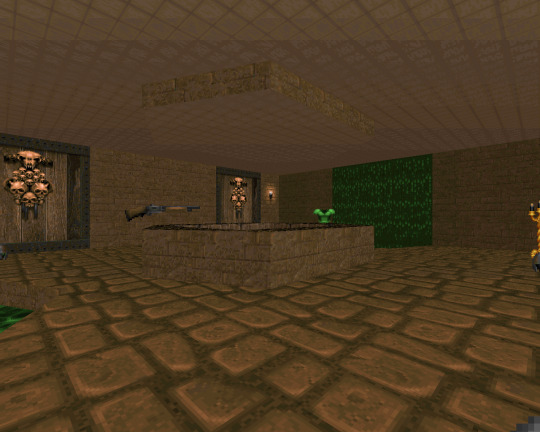



Capone’s Pit
Game: Doom II
Year: 1996
Source Port: Any
Specs: MAP01
Gameplay Mods: None
Author: "Capone”
idgames | doomwiki | onemandoom
Capone’s main claim to fame is as the author of the AOL Girls Museum. His other three releases are all edits of previously existing maps, however, with questionable differences. Capone’s Pit is more or less straight out of 1994 with its simple rooms and squat design. The action level is pretty low, though, with the boss encounter consisting of a pair of revenants in a library. Down for a relaxing stroll through the early years?
Click here if you’d like to read my full review.
#doom#games#game mods#retro gaming#retrogaming#doom WAD#doom mod#screenshot#gallery#review#1996#Doom II#Capone's Pit#PIT08
10 notes
·
View notes
Photo
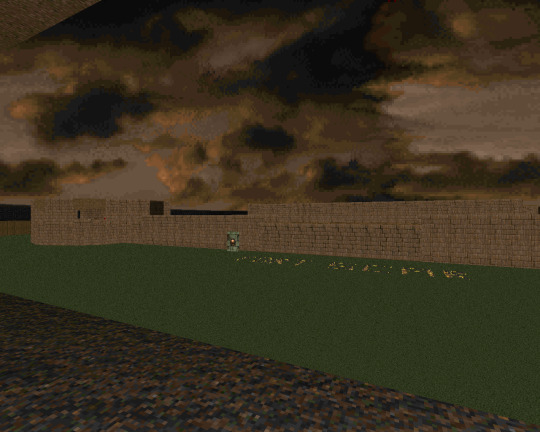


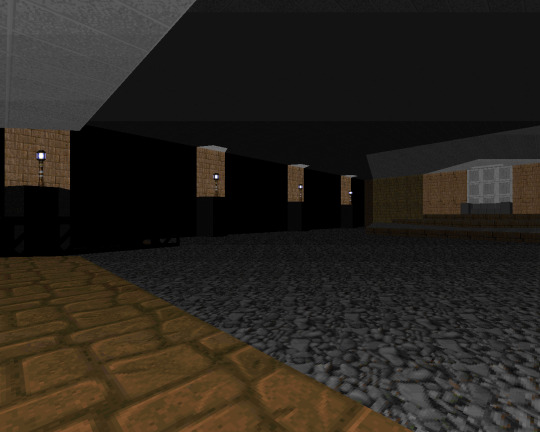

Fort Scar
Game: Doom II
Year: 1997
Source Port: Any
Specs: MAP01
Gameplay Mods: None
Author: "Capone”
idgames | doomwiki | onemandoom
Look familiar? This is an edit of Fortress of Doom (2) by Ryan Hilman. The actual structure of the castle and its encounters is virtually the same but Capone streamlined progression by making only one of the castle walls a functional lift. He also eliminates the damage floor inside the keep, paving over it with pebbles. This edit is primarily why I wonder what he’s actually responsible for in his pre-AOL Girls Museum releases.
Click here if you’d like to read my full review.
#doom#games#game mods#retro gaming#retrogaming#doom WAD#doom mod#screenshot#gallery#review#Doom II#1997#Fort Scar#FORTSCAR
6 notes
·
View notes